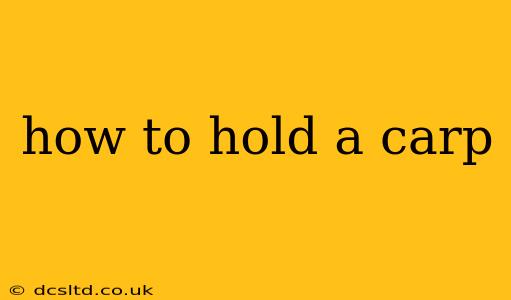How to Hold a Carp: A Guide to Safe and Responsible Handling
Carp are strong, powerful fish, and knowing how to handle them correctly is crucial for both their well-being and your safety. Improper handling can lead to injury for both you and the fish, potentially causing damage to its scales, fins, or even internal organs. This guide provides detailed instructions on how to safely hold a carp, covering various scenarios and considerations.
Why Proper Handling is Important
Before diving into the techniques, let's understand why proper handling is so vital. Carp are sensitive creatures, and rough handling can cause significant stress, leading to:
- Scale damage: Rough hands or inappropriate holding techniques can easily scrape or damage a carp's scales, making them susceptible to infection.
- Fin damage: Similar to scales, fins are delicate and can be easily torn or broken, hindering the fish's ability to swim and potentially leading to infection.
- Internal injuries: Squeezing a carp too tightly can cause internal injuries, particularly to its delicate organs.
- Increased stress levels: Stress weakens the immune system, making the carp more vulnerable to disease.
How to Hold a Carp Safely: Step-by-Step Guide
-
Wet your hands: This reduces friction and prevents damage to the fish's slime coat, a crucial protective layer.
-
Support the fish's weight: Never hold a carp solely by its gills or by lifting it vertically. Instead, gently cup your hands under its body, supporting its weight evenly.
-
Maintain a secure grip: Your hands should be positioned to prevent the carp from slipping. A good technique is to have one hand supporting its belly and the other gently cradling its body.
-
Minimize handling time: Keep the carp out of the water for the shortest possible time. Quickly perform any necessary actions (e.g., measuring, photographing) and return it to the water as soon as possible.
-
Hold the carp horizontally: Keeping the carp horizontal ensures its internal organs are not compressed. Avoid holding it vertically or at an angle.
-
Use a landing net: Always use a landing net with a soft mesh to carefully lift the carp from the water. Avoid any sudden movements or jerking motions that might damage the fish.
-
Avoid touching the eyes and gills: These areas are extremely sensitive and vulnerable to injury.
What if the Carp is Very Large?
Handling very large carp requires extra caution. You might need assistance from another person to help support the fish's weight and prevent accidental drops. Consider using a specialized carp sling to lift and support the fish safely.
How Should I Hold a Carp for Weighing?
For weighing, use a weigh sling or scale designed for fish. Never lift the carp by the gills or tail. Place it gently into the sling or scale, and ensure it's supported evenly to avoid stress and injury.
How Do I Hold a Carp for a Photo?
When taking photos, aim for a quick and respectful approach. Keep the carp supported and wet, minimize handling time, and return it to the water immediately after.
What Should I Do if I Accidentally Hurt a Carp?
If you accidentally injure a carp, assess the damage. Minor scrapes might heal on their own, but more significant injuries require immediate action. If possible, contact a local wildlife agency or fisheries expert for guidance. In the case of severe injury, euthanasia might be the most humane option. However, this should only be done with guidance from a professional.
Remember, responsible angling and careful handling are essential for the conservation of carp populations. By following these guidelines, you can enjoy your fishing experience while ensuring the well-being of these magnificent fish.
